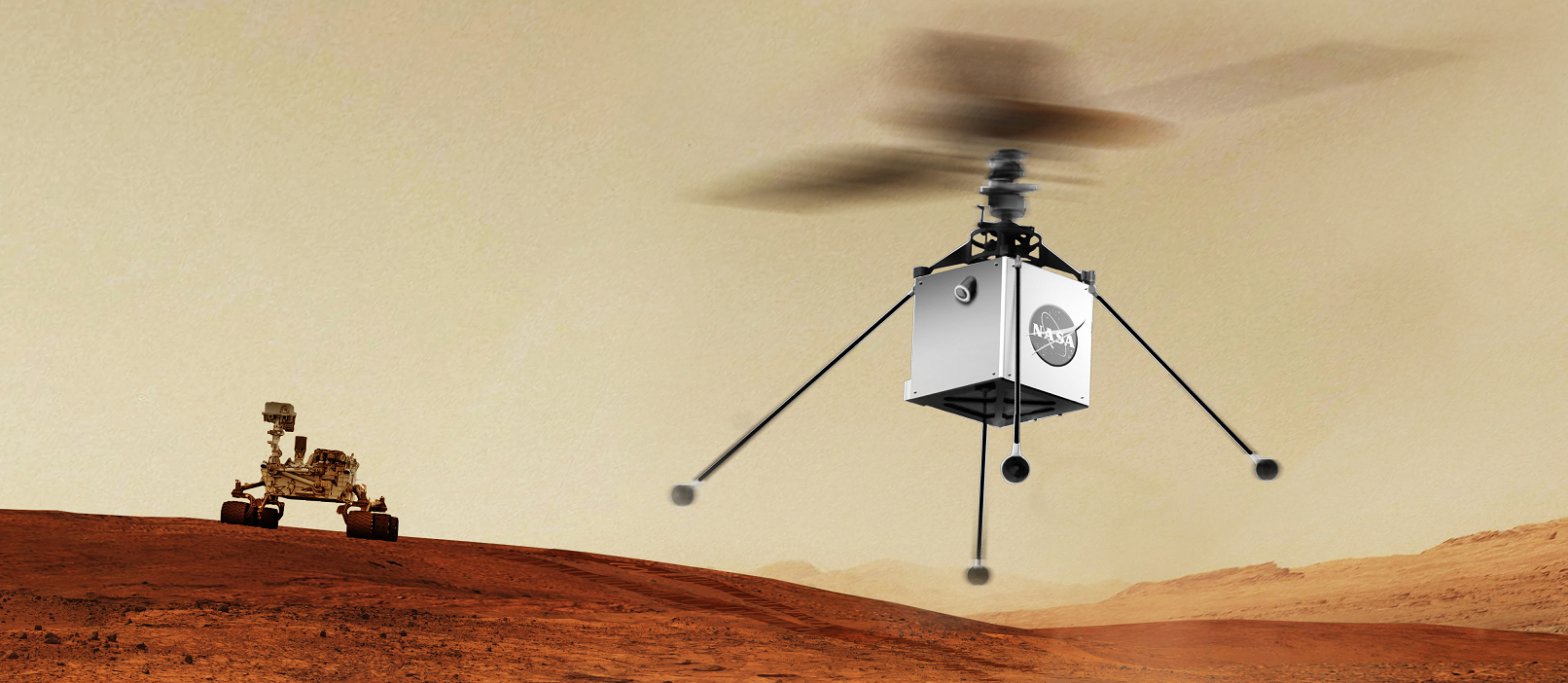Helicopter to Fly on Mars in 2020
July 09, 2018
AeroVironment, Inc. of Monrovia, California revealed its critical role in collaborating with NASA’s Jet Propulsion Laboratory (JPL) in Pasadena, California to build the “Mars Helicopter” for NASA’s Mars Exploration Program. Program officials plan to have the Mars Helicopter flying on Mars in less than three years.
AeroVironment, an unmanned aircraft system (UAS) or “drone” developer, is currently building the flight versions of their subsystems which will be integrated into the Mar Helicopter’s JPL-built airframe. JPL will then install the finished Mars Helicopter into the Mars 2020 Rover for its journey to a yet-to-be-determined Martian landing site.
Development of the helicopter began in August 2013. The Mars Helicopter weigh under four pounds and its fuselage is about the size of a softball. The propulsion system uses twin, coaxial or counter-rotating blades that negate the need for a tail rotor: something important when considering the size and weight costs associated with space travel.
The rotors also spin at a rate of almost 3,000 rpm, about 10 times the rate of an Earth-borne helicopter.
The air density near the surface of Mars is approximately the same as the air density at 100,000 feet on Earth, so AeroVironment used airfoil design principles and simulation tools used to achieve record high-altitude flights – one of the company’s specialties – and incorporated them into the Mars helicopter design.
The company recently formed a joint venture to develop solar-powered high-altitude long-endurance, or HALE, UAS for commercial operations. This category of UAS is also referred to as high-altitude pseudo-satellites, or HAPS.
“AeroVironment’s deep, rich and diverse history of innovation combined with our experience with near-space aircraft like Pathfinder and Helios make us uniquely suited to collaborate with NASA and JPL on this historic, interplanetary venture,” says AeroVironment President and CEO Wahid Nawabi.
The Mars Helicopter project is led by JPL with team members across JPL, AeroVironment, NASA Ames Research Center, and NASA Langley Research Center. The AeroVironment team has worked closely with NASA rotorcraft experts at the Ames and Langley research centers and with JPL electrical, mechanical, materials, vehicle flight controls, and systems engineers. AeroVironment’s contributions to the first Mars Helicopter include design and development of helicopter’s airframe and major subsystems, including its rotor, rotor blades, hub and control mechanism hardware. The company also developed and built high-efficiency, lightweight propulsion motors, power electronics, landing gear, load-bearing structures, and the thermal enclosure for JPL’s avionics, sensors, and software systems.
AeroVironment’s first subscale Mars helicopter prototypes date back to May 2016, when the company delivered a “rotor and landing gear” prototype to JPL, where it was coupled to a JPL-developed controller. The prototype demonstrated free flight in a simulated Mars environment and proved that flight on Mars is feasible.
In the fall of 2017, AeroVironment delivered rotor, landing gear, fuselage shell, and solar panel substrate for integration into two JPL-built Engineering Development Model Mars Helicopters – essentially a fuselage composed of flight avionics, onboard power, telecom, flight control, and sensor packages.
One of the development models was used for flight demonstration in JPL’s large 25-foot space simulator. The other was used for environmental testing, including thermal tests to ensure the vehicle can endure frigid Mars nights, and vibration tests to make sure it is rugged enough to survive launch. Both vehicles passed the rigorous tests, paving the way for the development and fabrication of the final, Mars-bound version.
Program officials say the Mars Helicopter will have enough battery power for one two- to three-minute flight per day.
“The Mars Helicopter effort also benefits from the ultra-lightweight and ultra-high-precision methods integral to our nano projects that have been developed in our MacCready Works laboratory, where we’ve assembled a dedicated team of the industry’s brightest and most experienced thinkers to solve some of today’s greatest technological challenges,” says Nawabi.
Endless propulsion, materials, and connectivity innovations mean that covering technology news in the aerospace industry is never dull.
Kucinski, William. (2018). “NASA and AeroVironment are building a helicopter for Mars”. Retrieved from https://www.sae.org/news/2018/06/nasa-and-aerovironment-are-building-a-helicopter-for-mars.

